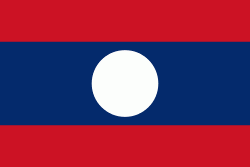Luang Namtha Province (Louangnamtha)
The province contains the Nam Ha National Biodiversity Conservation Area and is one of the main sugar cane and rubber producing areas of Laos with numerous plantations. There are some 20 temples in Muang Sing, including Wat Sing Jai and Wat Namkeo. The anthropological Luang Namtha Museum is in Luang Namtha.
The history of Luang Namtha province is traced to inhabitants who lived there about 6,000 years ago, evidenced by archaeological finds of stone implements discovered from the Nam Jook River Valley in Vieng Phoukha. The Xieng Khaeng Chronicles also mention existence of Xieng Khaeng town in the early-15th century, on the shores of the Mekong River. As its prosperity increased it became a vassal of the Lan Na Kingdom of northern Thailand until the early-16th century. From the mid-16th until the early-19th century it came under Burmese control. In the first half of the 19th century, it was under Siamese rule and war-torn. In 1885, Chao Fa Silinor, supported by 1,000 Tai Lue people took control of Muang Sing, attracted by its agricultural lands.
In 1890, the Tai Yuan occupied the Nam Tha Valley for a short period of two years, and thus Muang Houa Tha came to be reestablished. It was during this period that Vat Luang Korn, one of Luang Namtha's biggest temples, was built in 1892. In 1894, the French, British, and Siamese colonists, decreed that the province would be administered by the French. The border was redrawn with the Mekong River serving as the northern border (along its northern reaches of Muang Sing to Chiang Saen) between French Indochina and British Burma. This was followed by migration of the Tai Dam people from Sip Song Chou Tai from northwestern Vietnam who settled in the newly created Tong Jai Village, on the east bank of the Nam Tha River. Other ethnic groups, such as the Tai Neua, Tai Kao, Akha, Lanten, Yao and Lahu from Sipsongpanna in Burma and northwest Vietnam also migrated to the province. During French colonial rule, the provincial capital of Luang Namtha was the heart of the Sipsongpana civilization, which later moved to Yunnan province in southern China.
After France withdrew from Indochina in the late-1950s, the Houa Thas were in conflict with the US-supported Royal Lao Army against Pathet Lao forces, and from 6 May 1962 the area was under Pathet Lao control. At this time the province was given its present name. The territory between Houei Xay and Vieng Phoukha, known as Houa Khong province, was royalist-controlled until the Lao People's Democratic Republic was established in 1975. From 1975 to 1983 Houa Khong and Luang Namtha were a single province and subsequently divided into Luang Namtha and Bokeo provinces.
The capital of the province, Luang Namtha, had to be shifted in 1976 to a higher ground, by about 7 km, as the original city was not only prone to floods, but was also substantially destroyed during the Second Indochina War. The city has grid pattern layout and is surrounded by green paddy fields and is a hub of economic activity.
Map - Luang Namtha Province (Louangnamtha)
Map
Country - Laos
 |
 |
| Flag of Laos | |
Present-day Laos traces its historic and cultural identity to Lan Xang, which existed from the 13th century to the 18th century as one of the largest kingdoms in Southeast Asia. Because of its central geographical location in Southeast Asia, the kingdom became a hub for overland trade and became wealthy economically and culturally. After a period of internal conflict, Lan Xang broke into three separate kingdoms: Luang Phrabang, Vientiane and Champasak. In 1893, the three territories came under a French protectorate and were united to form what is now known as Laos. It briefly gained independence in 1945 after Japanese occupation but was re-colonised by France until it won autonomy in 1949. Laos became independent in 1953, with a constitutional monarchy under Sisavang Vong. A post-independence civil war began, which saw the communist resistance, supported by the Soviet Union, fight against the monarchy that later came under influence of military regimes supported by the United States. After the Vietnam War ended in 1975, the communist Pathet Lao came to power, ending the civil war. Laos was then dependent on military and economic aid from the Soviet Union until its dissolution in 1991.
Currency / Language
| ISO | Currency | Symbol | Significant figures |
|---|---|---|---|
| LAK | Lao kip | â‚ | 2 |
| ISO | Language |
|---|---|
| EN | English language |
| FR | French language |
| LO | Lao language |















